

Exploring our past to sort out myth from reality
Share this Page on
Facebook or Twitter

These are the voyages of the TimeShip Anachron.
Our Mission: To boldly explore the past, dispelling
mythinformation and mythconceptions
of American History along the way.
 Visit us on Facebook
Visit us on Facebook
Meet MythAmerica Series

Pt 1 Pt 2 Pt 3 Pt 4 Pt 5 Pt 6 Pt 7
Walk 1000 Miles in My Moccasins, Part 6
The Nightmare Continues
The tragedy of the Cherokee Removal seems to have been known widely around the US at the time (as witnessed by the letter from Ralph Waldo Emerson to President Van Buren in 1838 described previously). But time and history have a way of marching on and leaving the horrific stories of the poor and downtrodden and dispossessed behind.
Oh, the grand and glorious stories of Civil War battles never faded, of course! Georgia and other Confederate States have made sure that every excruciating detail has been preserved in the annals of their own histories. Grand monuments are erected everywhere to the famous, the infamous, and even the foot soldier. The Chickamauga Battleground—just miles from where the Cherokee were imprisoned by the thousands in the primary concentration camps prior to their Removal!—is loaded with grand and glorious statuary to make sure no one ever forgets “what happened there.”
Those monuments weren’t even put up shortly after the events—veterans began putting them up in 1894, thirty years after the War, and continued adding to them right on up to 1976. So it certainly can’t be said that folks are inclined to just “put the past behind them” and ignore portions of American history important to their own interests.
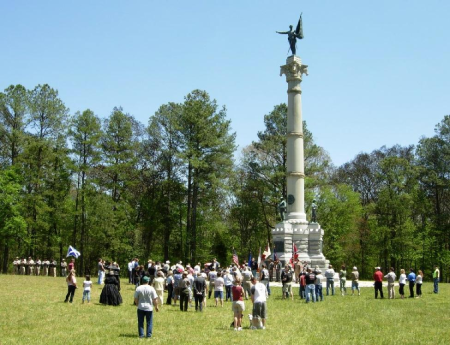
But up until 1987, you had to search high and low in the US to find a physical hint of the Trail of Tears events. I would suppose it was the American Indian Movement of the 1970s that brought the story back to the attention of the authors of “popular history.” Out of the midst of civil disobedience and general agitation by Native Americans in that tumultuous time in US history, a variety of books chronicling Native American history arose. It started with Bury My Heart at Wounded Knee in 1971, which covered the broad history of many tribes–focusing on the tribes of the West.
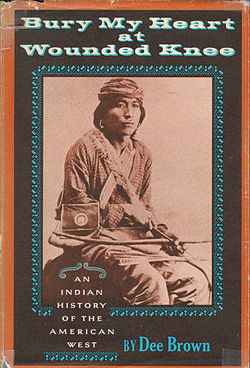
In 1972, one of the first books focusing on the Cherokee story came out, Only the Names Remain: The Cherokees and the Trail of Tears.
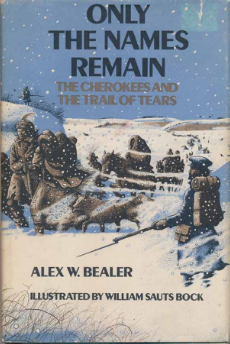
By the 1980s, a number of volumes covering the Trail of Tears story were in print, including the 1989 Trail of Tears: The Rise and Fall of the Cherokee Nation.
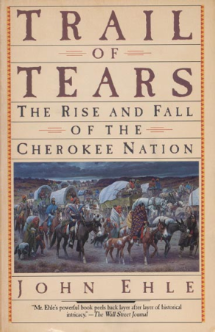
In 1987, the US Congress finally responded to this growing interest in the topic, and established the Trail of Tears National Historic Trail, under the auspices of the National Park Service. Extensive efforts were made to locate and verify the actual paths and roads that the Cherokee took on their forced trek to the Oklahoma Indian Territory. Areas of Alabama, Arkansas, Georgia, Illinois, Kentucky, Missouri, North Carolina, Oklahoma, and Tennessee are now peppered with the Trail of Tears official signs. And each of the states provides information and planning materials for those who would like to explore some or all of the portions of the Trail.

Actually, even though the majority of the Cherokee who were rounded up for the trek lived in Georgia, and the Georgia government of the 1830s was the primary agent behind the scenes pushing the US government for the Removal, it was 2011 before any official recognition came that the first portions of the Trail of Tears started at the removal forts and camps in Georgia.
From the Newnan, Georgia, Times-
Georgia now officially landmarked as part of infamous Trail of Tears
By JEFF BISHOP
It took four years, countless false starts, research, revisions, more revisions, permissions, inter-
As president of the Georgia chapter of the Trail of Tears Association, I have helped to lead an effort to research routes that were used in the Indian Removal of the early 19th century. When the U.S. Congress first recognized 2,200 miles of the Trail of Tears as a National Historic Trail in 1987, Georgia was completely left out, even though more Cherokees were living in Georgia than in any other state at the time of their removal in 1838. We argued that Georgia, the largest part of the original Cherokee homeland and the site of 14 military Indian removal posts, should have been included. Two years ago, the U.S. Congress agreed and finally included Georgia as part of the Trail of Tears National Historic Trail, essentially doubling the size of the Trail in the process.
While we advocated for Georgia’s inclusion, we were simultaneously researching significant Cherokee sites, likely routes used for their removal, and the location of military posts. All of this was done with significant cooperation and funding from the National Park Service, as well as massive volunteer effort. Last week our efforts paid off with the unveiling of new wayside exhibits at the Big Spring Park in Cedartown, and new Trail of Tears signage along roads used in the removal between Cedartown, Cave Spring, and Rome. It was gratifying to see at least a portion of the Trail of Tears marked in Georgia after years of work toward that goal.
The Georgia Chapter of the TOTA is continuing efforts to get more and more of the historical sites recognized. But for now, the route from Cedartown to Rome is marked.

And the Major Ridge home, down the road and around the corner from my former home in Rome, which now holds the Chieftains Museum, is a recognized site on that Trail of Tears.
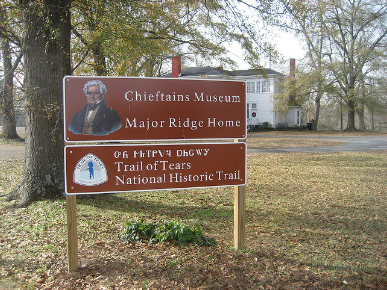
This is all certainly fitting, as it all “started here.”
Once the Cherokee were rounded up into the removal forts, and hustled on their way to the embarkation concentration camps near Chattanooga, Tennessee, the Removal began in earnest. The suffering that they endured in the forts and camps was only a taste of what was to come.
When I first heard about the Trail of Tears years ago, the story was so vague in my mind I just pictured some woodland Indians, dressed in buckskin like Tonto, taken from their tipis or wigwams (I wasn’t sure which) and led through more woods to get to wherever it was they were going. It never dawned on me that no, many lived in log homes just like other settlers … and some wore the same kind of clothing as southern gentlemen of the time—including top hats, tall collars, cravats, and suitcoats!
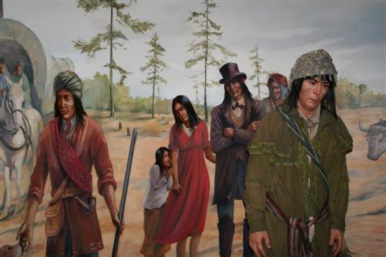
Nor did I realize that it wasn’t just some short trip … in some cases it was as far as—ON FOOT—over 1,000 miles. Some of them heading out in the worst drought in recorded history for the area, others later travelling in the coldest winter in anyone’s memory. Most of them with just the clothes on their backs to last the whole trip, many without even shoes or moccasins if they happened to not ave any on when the soldiers with bayonets arrived.
And since they lived in Georgia—and the Removal started in May—certainly none of them had “winter clothes” on. No eskimo-
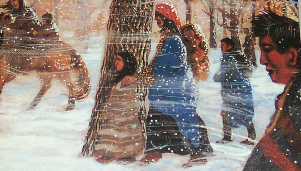
Men, women, the elderly, children, infants—none prepared with clothing for a thousand mile journey. I find this mind-
And back when I lived in Michigan in the frigid north, I wouldn’t think of going outside in the snow without my hooded parka, insulated gloves, warm hat, wooly socks, knee-
Guilty of nothing other than being born with Cherokee genes, and sitting on property someone else wanted.
So … what happened then?
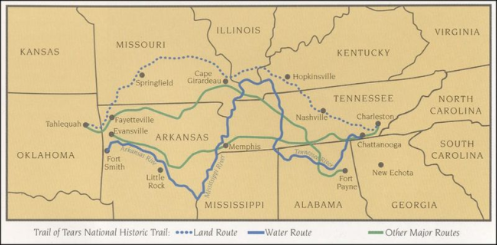
Well, not all of them walked most of the way. There was an initial attempt to take some primarily by water. The plan seems to have been to cram them on flatboats pulled behind steamboats part of the way.
Three groups [totaling 2800] left in June of 1838 travelling by rail, boat, and wagon primarily on the Water Route. But the detachments found themselves making the journey in the hottest part of the year when the river levels were too low for navigation.
Under the generally indifferent army commanders, human losses for these first groups of Cherokee removed were extremely high. Sickness and death rates caused by drought, bad water, bad diet and physical exhaustion were especially high among children. Some of the Cherokee left almost naked and without shoes or only in moccasins and refused government clothing because they felt it would be taken as an acceptance of being removed from their homes. Some refused government food; others were given food that was not normally part of their diet, such as wheat flour, which they did not know how to use. One military estimate of the death in one of the parties was put at 17.7 %, with half of the dead being children. [Source]
The National Park Service Trail of Tears website continues the story.
Three groups left in the summer, traveling from present-
Those travelling over land were prevented from leaving in August due to a summer drought. The first detachments set forth only to find no water in the springs and they returned back to their camps. The remaining Cherokees asked to postpone removal until the fall. The delay was granted, provided they remain in the camps until travel resumed. The Army also granted John Ross’s request that the Cherokees manage their own removal. The government provided wagons, horses, and oxen; Ross made arrangements for food and other necessities. In October and November, 12 detachments of 1,000 men, women, children, including more than 100 slaves, set off on an 800 mile-
The National TOTA.org website describes plans for the travel over the Land Routes.
The rest of the Cherokees traveled to Indian Territory overland on existing roads. They were organized into detachments ranging in size from 700 to 1,600, with each detachment headed by a conductor and an assistant conductor appointed by John Ross. The Cherokees who had signed the treaty of New Echota were moved in a separate detachment conducted by John Bell and administered by U.S. Army Lt. Edward Deas. A physician, and perhaps a clergyman, usually accompanied each detachment. Supplies of flour and corn, and occasionally salt pork, coffee, and sugar, were obtained in advance but were generally of poor quality. Drought and the number of people being moved reduced forage for draft animals, which often were used to haul possessions, while the people routinely walked.
The most commonly used overland route followed a northern alignment, while other detachments (notably those led by John Benge and John Bell) followed more southern routes, and some followed slight variations. The northern route started at Calhoun, Tennessee, and crossed central Tennessee, southwestern Kentucky, and southern Illinois. After crossing the Mississippi River north of Cape Girardeau, Missouri, these detachments trekked across southern Missouri and the northwest corner of Arkansas.
Road conditions, illness, and the distress of winter, particularly in southern Illinois while detachments waited to cross the ice-
From the National Park Service Trail of Tears website
The northern route, chosen because of dependable ferries over the Ohio and Mississippi Rivers and a well-
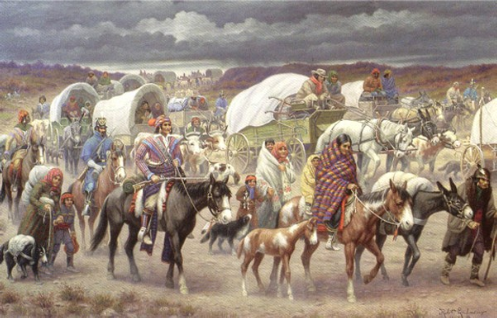
“We found the road literally filled with the procession for about three miles in length. The sick and feeble were carried in waggons . . . a great many ride horseback and multitudes go on foot—even aged females, apparently nearly ready to drop into the grave, were traveling with heavy burdens attached to the back—on the sometimes frozen ground, and sometimes muddy streets, with no covering for the feet except what nature had given them.“
A Cherokee survivor later recalled:
Long time we travel on way to new land. People feel bad when they leave Old Nation. Women cry and made sad wails. Children cry and many men cry, and all look sad like when friends die, but they say nothing and just put heads down and keep on go towards West. Many days pass and people die very much.
Remember Reverend Butrick? He continued his journal of his experiences traveling with the Cherokee on the Trail of Tears.
Reverend Butrick and his wife Elizabeth volunteered and were assigned to a detachment coordinated by Richard Taylor who followed the northern route from Brainard, Tennessee through Nashville, then to Hopkinsville, Kentucky, across the Ohio and Mississippi rivers, north near Rolla, Missouri, then on to Springfield and finally entered Indian Territory near today’s Westville, Oklahoma. Taylor’s Detachment of 1029 left on September 20, 1838 and journeyed for 186 days, arriving March 24, 1839 with 942 survivors.
[Here is one of] Reverend Butrick’s observations about the journey. It would be redundant to repeat his numerous references to the 87 deaths and burials. The weather and illness took its toll.
November 26 – “As the fires began to be kindled, an aged Cherokee, who had been sick all the way, lay down by the fire, when his clothes caught fire, and he sprang up, but before he could be relieved, was burnt near to death. The poor old man who was burnt, was left at a house to be taken care of, but died in a few days.
The Wikipedia TOT article adds a few details of the travails along the Trail
Because of the diseases [cholera, dysentery, measles, smallpox, and more], the Indians were not allowed to go into any towns or villages along the way; many times this meant traveling much farther to go around them.
After crossing Tennessee and Kentucky, they arrived in Southern Illinois at Golconda about the 3rd of December 1838. Here the starving Indians were charged a dollar a head (equal to $21.83 today) to cross the river on “Berry’s Ferry” which typically charged twelve cents, equal to $2.62 today. They were not allowed passage until the ferry had serviced all others wishing to cross and were forced to take shelter under “Mantle Rock,” a shelter bluff on the Kentucky side, until “Berry had nothing better to do”. Many died huddled together at Mantle Rock waiting to cross.
Several Cherokee were murdered by locals. The killers filed a lawsuit against the U.S. Government through the courthouse in Vienna, suing the government for $35 a head (equal to $763.88 today) to bury the murdered Cherokee.
On December 26, Martin Davis, Commissary Agent for Moses Daniel’s detachment, wrote: “There is the coldest weather in Illinois I ever experienced anywhere. The streams are all frozen over something like 8 or 12 inches thick. We are compelled to cut through the ice to get water for ourselves and animals. It snows here every two or three days at the fartherest. We are now camped in Mississippi swamp 4 miles from the river, and there is no possible chance of crossing the river for the numerous quantity of ice that comes floating down the river every day. We have only traveled 65 miles on the last month, including the time spent at this place, which has been about three weeks. It is unknown when we shall cross the river….”
I could continue the litany, but I think readers should have a clear picture by now why the Cherokee referred to this era of their history as Nu na da ul tsun yi (the place where they cried).
The Trail of Tears.
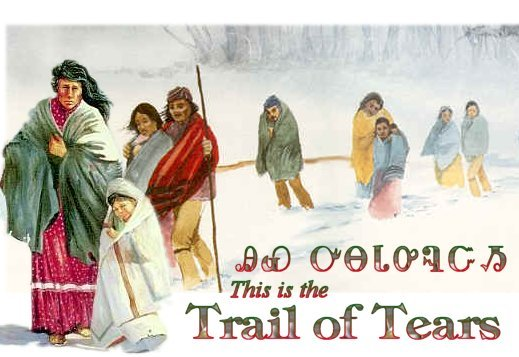
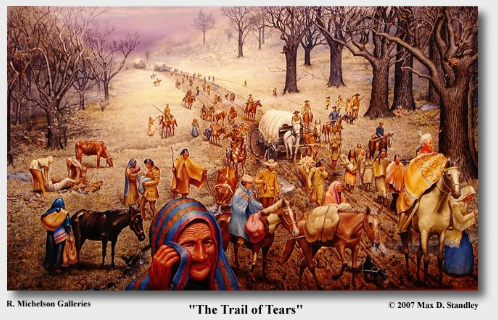
In December 1838 Principal Chief John Ross and his wife left the Cherokee homeland with the last group to be “removed.” He carried with him the records and laws of the Cherokee Nation. At that time thousands of Cherokees were trapped east of the Mississippi by the harsh winter, and the deaths continued. Including Chief Ross’s wife, Quati, who died February 1, 1839 near Little Rock, Arkansas.
But at least the surviving Cherokee as a group got $5 million to get a fresh start, right?
Well, not exactly. The money didn’t go to any Cherokees individually, and none got any “reparations” for what they left back in the homeland. So it wasn’t like modern times when at least some individual people after a big disaster like Hurricane Katrina get financial help to rebuild their homes and lives. The money just went to setting up “public works” like grist mills. And … ahem … it wasn’t quite $5 million.
Later, adding to this stain on United States history, when a financial settlement was finally made, the federal government deducted over $1.2 million from the $5 million which was to be paid for Cherokee lands in Georgia, “for costs related to removal.”
History now labels this whole episode as the Trail of Tears. But back at the time, the commissioner of Indian Affairs had a different description of it.
“The commissioner of Indian affairs wrote in his [final] report: “…good feeling has been preserved, and we have quietly and gently transported 18,000 friends to the west bank of the Mississippi.” (Emerson: The Mind on Fire, p.279)
Don’t worry. Be Happy.
But of course, that is all ancient history. Why should modern Americans care about it? Especially modern American Christians. We’ll explore that question in the conclusion to this story.